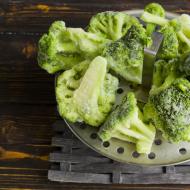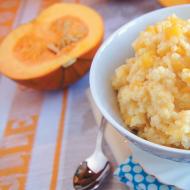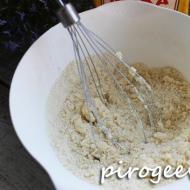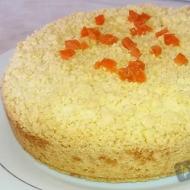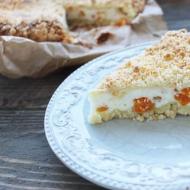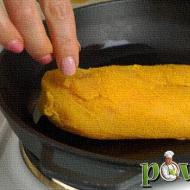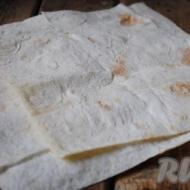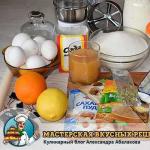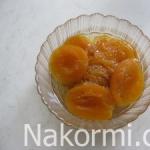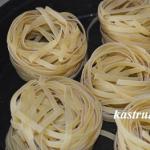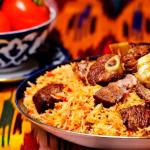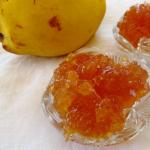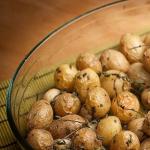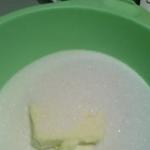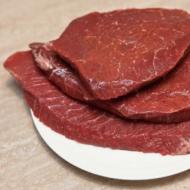
Ham calories. Beneficial properties of low-fat turkey ham Composition and calorie content of ham
· Turkey has so much sodium that it even surpasses beef and veal.
· Consumption of this mineral in food guarantees an increase in plasma volumes in the blood and normal metabolic processes occurring in the body.
· Regular consumption of turkey ham prevents the appearance of cancer cells.
· Etchina contains a lot of zinc, which increases immunity.
· Ham contains tyrosine, which stimulates the functioning of the brain, heart and blood vessels, and maintains dental health.
Low-fat turkey ham is the best example of a diet food (calorizer). It is also very useful to give it to children and women who are breastfeeding and people who have suffered severe injuries, as this product is rich in enzymes, nutrients and minerals. Thanks to the consumption of turkey ham, the amount of blood is quickly restored.
Semi-hard cheese 5% - low-fat cheese
The beneficial properties of cheese are undeniable; just a few pieces a day will provide the body with:
Calcium reserve
· Vitamins
Other useful substances.
Low-calorie boiled condensed milk is boiled condensed milk consisting of three components:
· Skimmed milk powder
· Skimmed milk
· Sugar substitute
Cooking method:
1) Powdered milk is baked
2) sugar substitute and milk are added
3) the finished condensed milk is cooled
This condensed milk is an optimal carbohydrate-free replacement for traditional boiled condensed milk, and it does not lose in taste or beneficial properties.
| Dumplings | ||||
| Ingredient | Definition | For what? | Benefit | Harm |
| Corn starch | Corn starch is a food additive used to thicken foods | The addition of cornstarch makes culinary products soft and tender. | 1) The nutritional properties of CC provide energy to the body's cells and promote the growth of muscle tissue. 2) KK is a supplier of carbohydrates to the human body, which are vital for the normal functioning of all organs. | May be harmful to a person with corn intolerance, which can lead to allergic reactions, skin rashes, etc. Not recommended for use by people with problems with the gastrointestinal system and increased blood clotting. |
| Wheat gluten (gluten) | Gluten is a complex protein found in most cereals, and in particular wheat, barley and rye. | Allows you to mix cereal flour with liquid. The more gluten contained in wheat, the easier it is to make elastic dough from it, which turns into fluffy and airy baked goods. | Gluten not only enriches the product with protein, but also promotes the binding of minerals and vitamins, which has a beneficial effect on the health of the consumer. | Gluten allergy (celiac disease) occurs in 1% of the population - that's 1 in 100-150 people (2). The immunity of such people perceives the protein of the substance as foreign, forcing the body to fight it. Moreover, even a small dose of gluten (0.1 g) can activate a serious allergy. |
| Egg | food product | to add a certain moisture content, as well as stickiness, airiness and volume to baked goods. | Large amounts of protein and nutrients | Harm to the body in case of individual intolerance (allergy) |
| Salt | Food supplement | As a spice | Physiologically essential microelement. Adds flavor to the dish. | If consumed excessively, salt retains water in the body, a large volume of which is “stored” by adipose tissue. |
| Light dumplings with chicken | Compound | Nutritional value per 100 g | |
| Our pancakes (g) | Traditional dumplings (g) | ||
 | Dough based on chicken bran flour Onion Salt Ground bell pepper | Proteins – 13.1 g Fats – 5.2 g Carbohydrates – 13.1 g PC – 152 kcal | Proteins – 8.96 g Fats – 9.73 g Carbohydrates – 27.34 g PC – 218 kcal |
| Light dumplings with beef and chicken | Compound | Nutritional value per 100 g | |
| Our pancakes (g) | Traditional dumplings (g) | ||
 | Dough based on bran flour Beef shoulder Chicken fillet Onion Salt Ground white pepper | Proteins – 16 g Fats – 5.5 g Carbohydrates – 11.7 g PC – 163 kcal | Proteins – 13.3 g Fats – 1.5 g Carbohydrates – 26.6 g PC – 176 kcal |
| Light dumplings with chicken and mushrooms | Compound | Nutritional value per 100 g | |
| Our pancakes (g) | Traditional pancakes (g) | ||
 | Dough based on bran flour Chicken Champignons Onion Garlic Salt Ground white pepper | ||
| Light dumplings with spinach and ricotta | Compound | Nutritional value per 100 g | |
| Our pancakes (g) | Traditional pancakes (g) | ||
 | Proteins – 15.2 g Fats – 5.9 g Carbohydrates – 13.3 g PC – 166 kcal | Proteins – 8 g Fats – 14 g Carbohydrates – 25 g PC – 258 kcal |
Instead of the usual composition of “harmful, but so beloved” nuggets, our chain presents chicken nuggets, where the high-carbohydrate ingredients of the nugget breading itself are replaced with a dietary breading made from bran flour, fiber from tomatoes, carrots and pumpkin.
Lasagna is made with bran pancakes, while regular lasagna is made with regular layers of pasta and contains more carbohydrates accordingly.
To reduce the fat content of the dish, beef and regular cheese are replaced with 5% semi-hard cheese and chicken fillet. And instead of Bechamel sauce, fresh tomatoes are used.
| Ready boxes |


Cafe stores offer ready-made meals packaged in plastic boxes, which are prepared in specialized production facilities.
Three facts about ready-made boxes:
1. Packaging of boxes is carried out in a modified gas environment;
2. This technology allows you to increase the shelf life of products up to 5 days without the use of preservatives;
3. At the same time, all the taste and quality of the product as a whole are preserved;
Dishes and their compositions correspond to the concept of “Proper Nutrition”; the following items are presented on the network:
Breakfast:
· Dumplings PG
· Pancakes PG
· Zapenka
Muesli with topping
Main dishes:
· Dumplings PG
· PG cutlets
· Boiled chicken breast
· Boiled turkey breast
· White fish
· Paste and Wok
In our dishes, almost all simple carbohydrates are replaced with complex ones, which allows you to make your favorite dishes low-calorie or even dietary, without losing the original taste of traditional dishes and their beneficial properties!


| Dessert |
Almost every person likes to treat themselves to dessert, but the “proper nutrition” regime, which is increasingly popularized among the masses, excludes this possibility.
How to be?
How to “sit on two chairs”?
Is it possible to eat Napoleon cake and not think about the extra calories?
We found answers to all questions in incredibly tasty, yet low-calorie desserts.
Our line of desserts includes the following:
· Cheesecake
· Honey cake
· Bird's milk
· Cake Prague
· Cake Napoleon's Dream
· Coffee-nut cake
Carrot cake
· Nut balls
· Syrniki
· Potato cake
In all desserts, simple carbohydrates are replaced with complex ones, while the taste and benefits of each dessert increase significantly compared to the original.
HERE IS THE COMPARISON TABLE FOR DESSERTS


Cellulose
 Cellulose
- the coarsest and most difficult part of the plant to digest by our digestion. Fiber is a plexus of plant fibers that make up the leaves of greens and cabbage, the peel of beans, fruits, vegetables, as well as the flower membrane of seeds and cereals.
Cellulose
- the coarsest and most difficult part of the plant to digest by our digestion. Fiber is a plexus of plant fibers that make up the leaves of greens and cabbage, the peel of beans, fruits, vegetables, as well as the flower membrane of seeds and cereals.
Dietary fiber - This is a complex form of carbohydrates, which our digestive system is not able to break down.
Note: everything that is not included in the list of permitted products is prohibited. The list of prohibited products at the end of the article is not exhaustive. If you doubt whether a certain product can be eaten, and it is not on the list of allowed or prohibited, consider it prohibited.
Cooking methods products - boiling, stewing, steaming, baking in the oven, grilling, grilling or frying without adding oil.
The following products are permitted without restriction unless otherwise specifically noted in the listing.
ALLOWED:
1. Lean meat:
veal: chop, cutlets;
beef: tenderloin, beefsteak, beef steak, sirloin, roast beef, minced meat no more than 5% fat (except for entrecote and ribs);
horsemeat;
rabbit.
2. By-products:
beef liver
bird liver
calf tongue
lamb tongue
beef tongue (front)
3. All types of fish are allowed: incl. fatty, lean, fresh, frozen, dried, smoked, canned, and crab sticks (ideal composition of crab sticks: per 100 g of product 0.1 g of fat, 6 g of carbohydrates, 9 g of proteins).
4. All types of seafood are allowed:
shrimps;
crabs;
crayfish;
oysters;
mussels;
scallops;
lobsters;
sea urchins;
squid;
shellfish;
caviar (in moderation, contains a lot of salt);
seaweed, cabbage;
other seafood.
5. All types of poultry are allowed, with the exception of ducks and geese:
chicken;
turkey;
guinea fowl;
pigeon;
quail;
partridge;
pheasant;
other types of poultry
All poultry is consumed without skin or tail!
6. Lean ham (from 2% to 4% fat):
low-fat pork ham;
turkey ham;
chicken ham;
etchina grison;
bresaola;
Spanish sesina ham;
basturma, etc.
By ham, the French most often mean natural ham (a piece of meat prepared in a special way), and not what we call ham in Russia - sausage prepared in a special way! The fat content of ordinary Russian ham is around 30%, so choose pickily!
7. Chicken and quail eggs in any form:
hard-boiled
soft-boiled
fried eggs
omelette
8. Low-fat dairy products no limits:
milk with fat content up to 1.5%;
cottage cheese 0%;
cheese 0%;
yoghurts without additives or fillers.
Flavored yogurt or with fruit filling – maximum 2 pcs. in a day.
9. At least one and a half liters of fluid per day:
water;
light drinks 0 calories, incl. Coca-Cola diets, etc.;
herbal infusions;
tea;
coffee.
10. Plant proteins
tofu;
seitan.
11. Oat bran– 1.5 tablespoons per day
ALLOWED ADDITIVES, SEASONINGS, DRESSINGS:
Skim milk powder – recommended;
sweeteners 0% – without restrictions (except fructose, glucose, sorbitol);
vinegar (balsamic vinegar can be used in small quantities at the first stage, other types of vinegar up to 4 tablespoons per day);
soy sauce (salty);
tomato sauce and canned tomatoes (no sugar, in moderation);
adjika (moderate);
caraway;
garlic;
herbs (parsley, basil, coriander, dill, tarragon, mint, rosemary, etc.);
any spices (turmeric, cloves, anise, cumin, cardamom, cinnamon, paprika, saffron, nutmeg, etc.);
gherkins - up to 2 pieces per day;
onions can be added when preparing dishes, but not eaten;
lemon and lemon juice to improve flavor as a condiment, not a fruit;
salt in moderation;
mustard;
diet ketchup without sugar;
ginger;
yeast in small quantities;
sugar-free chewing gum;
paraffin (aka Vaseline) oil for dressing salads and sauces, but not for frying! More than 1 tablespoon per day has a laxative effect;
gelatin 0 calories;
vanilla;
agar-agar;
sugar-free sucking candies – maximum 4 pcs. per day, 7 kcal per candy.
FORBIDDEN:
Peanut;
all types of oil, except Vaseline;
chocolate;
fruits;
regular ketchup;
regular maoineuse;
olives;
sugar.
Once again, please note: this list of prohibited products is not exhaustive. If you doubt whether a certain product can be eaten, and it is not on the list of allowed or prohibited, consider it prohibited!
Ham is a delicacy meat that is produced mainly from pork.
Ham - smoked and salted pork ham, back or in rare cases front shoulder. It is also customary to smoke other parts, for example, ribs. There are hams made from chicken, turkey, bear, deer, etc.
They learned to smoke ham back in the days of Ancient Rome, in particular, already in the first century BC, Marcus Terence Varro described the technology for preparing ham in his own work “On Agriculture”.
Today you can find ham that is packaged in a tin along with a gelatinous jelly. These canned foods can also be stored at room temperature. The first author of the ham canning technology was an American named George Hormel, who founded the company Hormel Foods, which produced ready-made meat products.
Ham can be boiled-smoked, raw-smoked, molded, boiled, etc.
Ham is very popular in many countries.
The calorie content of ham is 270 kcal. The composition contains proteins - 14.0 g, fats - 24.0 g.
Famous varieties of ham:
Parisian ham is made exclusively from lean pork and has a delicious taste.
Parma ham is raw smoked ham from an Italian producer. Parma ham is classified as an appellation protected by origin. It is produced in the northern part of Italy. Strict control is expected not only of the production process of Parma ham itself, but also of the feed for pigs. Parma ham is kept in a special brine with a unique composition of spices, then dried under natural conditions for 10-14 months. Parma ham is served thinly sliced.
Ham has always been a mandatory attribute of the holiday table. This product is used not only for sandwiches, but also for preparing fillings, rolls, and salads.
Calorie content of ham in form
 Ham - salted back and front hams, boneless and with bones, smoked, boiled or baked. Along with ham in the form of hams, they also make ham in the form.
Ham - salted back and front hams, boneless and with bones, smoked, boiled or baked. Along with ham in the form of hams, they also make ham in the form.
Ham contains vitamin PP in form, plus iron, phosphorus, potassium, iodine and magnesium.
The calorie content of ham in the form is 278 kcal. The composition contains proteins - 22.6 g, fats - 20.9 g.
Shaped ham (also known as boneless ham) is made from front and back hams, pre-salted, less often smoked. The bones are removed from the hams, the skin and excess fat are cut off. A layer of lard of about 1-1.5 centimeters remains on the ham; the flesh is placed with the subcutaneous part towards the top in special molds, covered with a lid and pressed. The ham is cooked in molds placed in water, then cooled and removed, after which it is packaged in cellophane or parchment. Ham in the form is usually used for cold appetizers. This ham should have a dense consistency, the bacon should be white, and the fabric should be pink-red, without yellowing. At home, ham should be stored in dark, cool places, first wrapped in parchment or cellophane.
The assortment of ham is quite rich. There are many types and varieties of ham that find different uses in our kitchens.
Calorie content of Danish DAK ham
 Ingredients: ham, sugar, salt, water, gelatin, sodium nitrite, sodium triphosphate.
Ingredients: ham, sugar, salt, water, gelatin, sodium nitrite, sodium triphosphate.
DAK Danish ham has a pleasant salty taste, red-pink color, low fat content, tender texture with distinct whole pieces of meat, and a wonderful smell of fresh meat. The ham is surrounded by a jelly shell, which is based on the meat broth. The ham is packaged in a tin can with a key opener, making it convenient and safe to open the can.
Ham improves appetite, is a wonderful snack, and can be used in the preparation of fillings, salads, sandwiches, and meat rolls.
Ham should not be consumed by people who suffer from lung diseases, because... Nitrates are present among preservatives for color fixation and antimicrobial agents. Increased concentrations of these drugs in the human body can damage the respiratory system and lungs.
Calorie content of DAT Danish ham - 471 kcal. The composition included proteins - 18.0 g, carbohydrates - 1.0 g, fats - 4.0 g.
Ham can be used in the form of sandwiches and as a snack, added to salads and other dishes. Although ham cannot be called a low-calorie product, it is considered healthy for those who are on a diet. There are not many carbohydrates and fats in it, but there is enough protein. This product is suitable for those who are trying to adhere to low-carbohydrate or high-protein diets.
Calories in low fat turkey ham
 Turkey is one of the best examples of dietary meat. Turkey ham contains vitamins B1, B2, B3, B9, B6, C, A, E, PP, minerals: chromium, molybdenum, calcium, potassium, cobalt, magnesium, copper, manganese, iron, sodium, zinc, chlorine, phosphorus, sulfur.
Turkey is one of the best examples of dietary meat. Turkey ham contains vitamins B1, B2, B3, B9, B6, C, A, E, PP, minerals: chromium, molybdenum, calcium, potassium, cobalt, magnesium, copper, manganese, iron, sodium, zinc, chlorine, phosphorus, sulfur.
Turkey has such a sodium content that it was able to surpass veal and beef in this indicator. This mineral increases the volume of plasma in the blood and normalizes the metabolic processes that occur in the body. Low-fat turkey ham is recommended for the prevention of osteochondrosis, osteoporosis and joint diseases.
Including turkey ham in your diet can prevent the occurrence of cancer cells. Doctors also recommend this product to all those who are planning or are already on a diet. Ham contains a large amount of zinc, which improves immunity.
Calorie content of low-fat turkey ham is 77 kcal. The composition also included proteins - 15.0 g, carbohydrates - 2.0 g, fats - 1.0 g.
Ham contains tyrosine, which stimulates the functioning of blood vessels, heart and brain, and also has a beneficial effect on dental health.
Low-fat turkey ham is one of the best dietary foods. It can be given to children and nursing women, people who have suffered severe injuries, because... This product is enriched with minerals, nutrients and enzymes. Anyone can eat low-fat turkey ham, because it has almost no contraindications. You just need to remain confident in the freshness and quality of the product you buy.

